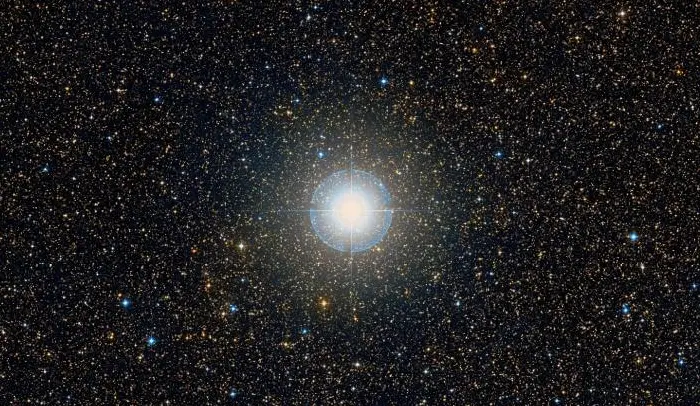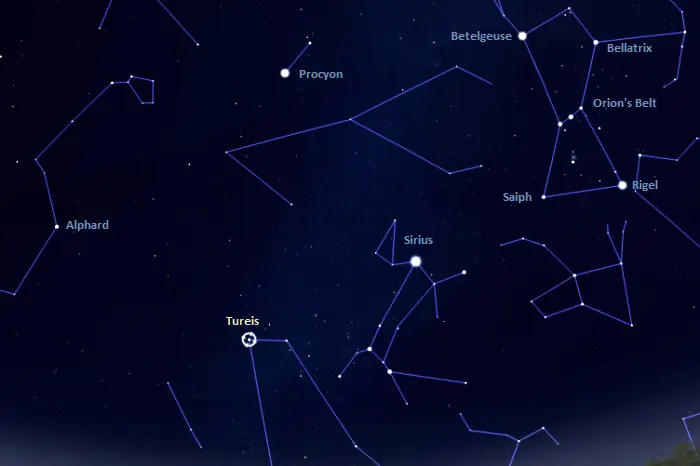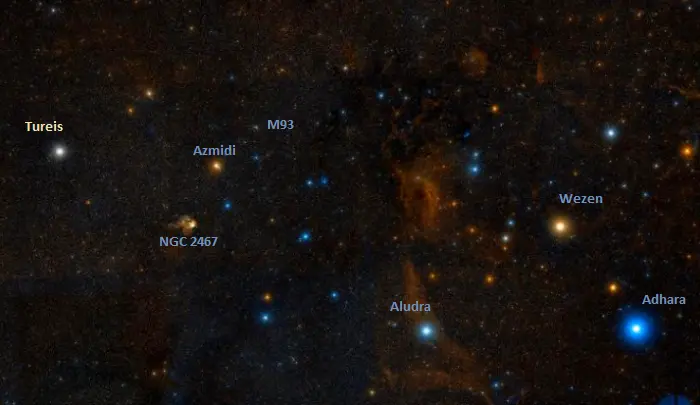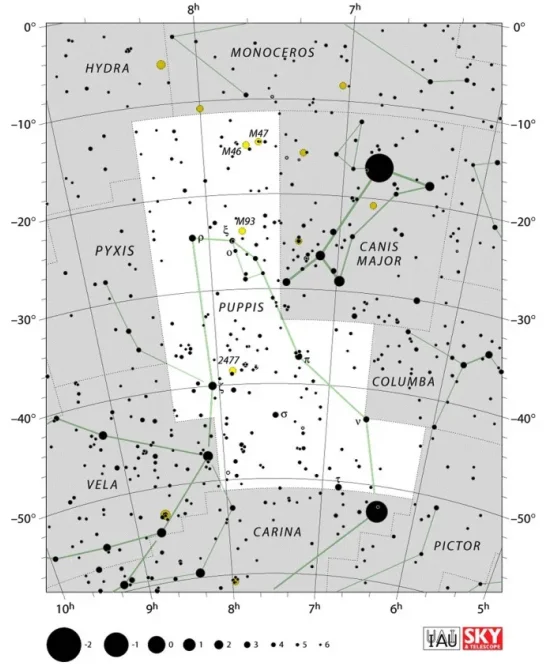Tureis, Rho Puppis (ρ Pup) is a bright giant star located 63.5 light-years away in the constellation Puppis. With an apparent magnitude of 2.78, it is the third brightest star in Puppis, after Naos and Pi Puppis. Tureis serves as the prototype of a class of evolved Am stars known as the Rho Puppis stars.
Star type
Tureis is an F-type bright giant with a mass of 1.85 solar masses and a radius of 3.41 solar radii. With a surface temperature of 6,920 K, it is 22 times more luminous than the Sun. The star has an estimated age of 2 billion years. It spins with a projected rotational velocity of 15 km/s.
The spectral type F5IIkF2IImF5II indicates that Tureis is an Am star, a chemically peculiar metallic-line star with strong and variable absorption lines of certain metals, such as strontium, barium, zinc, and zirconium, and deficiencies of others, such as calcium and scandium. Most Am stars are found in binary systems, but no companions have been found near Rho Puppis.

Tureis (Rho Puppis), image: Wikisky
Tureis is believed to be more evolved and luminous than most other stars of this type. It lies above the main sequence on the Hertzsprung-Russell diagram, in roughly the same location as Delta Scuti variables. It is a rare example of a star that is both an Am star and a Delta Scuti variable. The brightness of Rho Puppis has been observed to vary between magnitudes 2.68 and 2.87.
Delta Scuti stars (sometimes called dwarf cepheids) are young pulsating stars that show variations in brightness due to pulsations. Other than Delta Scuti in the constellation Scutum, well-known stars in this class include Altair in Aquila, Denebola in Leo, and Caph in Cassiopeia.
Tureis has a pulsation period of 0.14088143(3) days, or 7.1 cycles per day. As it pulsates its brightness varies with an amplitude of 0.15 and its radial velocity fluctuates by 10 km/s-1.
Facts
The variability of Rho Puppis was discovered by American astronomer Olin J. Eggen in 1956. Eggen measured a total amplitude of 0.15 magnitudes and classified the star as a Delta Scuti variable.
Tureis exhibits an infrared excess, indicating that it has a circumstellar dust disk. The disk orbits the star at a separation of 50 astronomical units.
Tureis made its closest approach to the Sun approximately 394,000 years ago, when it came within 11.6 light-years of our host star, which is comparable to the present distance of Procyon. Rho Puppis currently lies about 63.5 light-years away and is moving away from the Sun with a radial velocity of about 46 km/s.
In Chinese astronomy, Rho Puppis was part of an asterism called 弧矢 (Hú Shǐ), meaning Bow and Arrow. The asterism was part of the Well mansion, one of the southern mansions of the Vermilion Bird.
Name
The name Tureis (pronunciation: /ˈtjʊəreɪs/) comes from the Arabic word turais, meaning “small shield.” The name was also historically spelled Turais. Rho Puppis traditionally shared this name with Iota Carinae, now formally known as Aspidiske. The name Aspidiske has the same meaning as Tureis. It is derived from the Greek word for “small shield.”
The name Tureis was approved for Rho Puppis by the International Astronomical Union’s (IAU) Working Group on Star Names (WGSN) on September 12, 2016.
Location
Tureis is easy to find because it appears in an area full of exceptionally bright stars. It lies along the imaginary line extended from Saiph at the foot of Orion through Sirius, the brightest star in the sky. Sirius appears along the line drawn through the three stars of Orion’s Belt, and Saiph is part of Orion’s crooked hourglass pattern that makes the celestial Hunter recognizable.

The location of Tureis (Rho Puppis), image: Stellarium
The bright open cluster Messier 93 appears in the region between Tureis and Sirius, just northwest of the fainter Xi Puppis (Azmidi).
The star-forming region NGC 2467, nicknamed the Skull and Crossbones Nebula, appears between Tureis and Aludra, the faintest of the three stars that form a distinctive triangle below Sirius.

Tureis, Messier 93 and the Skull and Crossbones Nebula (NGC 2467), image: Wikisky
Constellation
Tureis lies in the constellation Puppis. Puppis is the largest of the three constellations that once formed Argo Navis (the Ship Argo), which represented the ship on which Jason and the Argonauts sailed to Colchis to retrieve the Golden Fleece. Puppis represents the ship’s stern, while the nearby Carina and Vela represent the keel and the sails. All three are Greek constellations, catalogued by Ptolemy of Alexandria in the 2nd century CE.
Puppis stretches across 673 square degrees of the southern sky and is the 20th largest of the 88 constellations. Its southern portion appears between Sirius and Canopus, the brightest stars in the sky, while the northern part appears east of Sirius, next to the constellation Monoceros (the Unicorn).

Puppis constellation map by IAU and Sky&Telescope magazine
Naos (Zeta Puppis), the brightest star in Puppis, is the nearest O-type star to the Sun. The hot blue supergiant shines at magnitude 2.25 from a distance of about 1,080 light-years. The constellation’s second brightest star, Pi Puppis (traditionally known as Ahadi), is a variable orange supergiant located 810 light-years away. Other bright stars in the constellation are also evolved giants and supergiants. They include the orange giants Tau and Sigma Puppis, the blue giant Nu Puppis, the yellow supergiant Azmidi (Xi Puppis), and the A-type supergiant 3 Puppis.
Notable deep sky objects in Puppis include the open clusters Messier 46, Messier 47, Messier 93, NGC 2451, and NGC 2477, the planetary nebulae NGC 2438 and NGC 2440, the protoplanetary Calabash Nebula, the supernova remnant Puppis A, and the star-forming regions NGC 2467 (the Skull and Crossbones Nebula) and CG4, popularly known as God’s Hand.
The best time of the year to observe the stars and deep sky objects in Puppis is during the month of February, when the constellation climbs higher in the evening sky. The entire constellation is visible from locations south of the latitude 40° N.
The 10 brightest stars in Puppis are Naos (Zeta Pup, mag. 2.25), Pi Puppis (mag. 2.733), Tureis (Rho Pup, mag. 2.78), Tau Puppis (mag. 2.95), Nu Puppis (mag. 3.173), Sigma Puppis (mag. 3.25), Azmidi (Xi Pup, mag. 3.34), c Puppis (HD 63032, mag. 3.61), a Puppis (HD 64440, mag. 3.71), and 3 Puppis (mag. 3.93).
Tureis – Rho Puppis
| Spectral class | F5IIkF2IImF5II |
| Variable type | Delta Scuti |
| U-B colour index | +0.17 |
| B-V colour index | +0.40 |
| Apparent magnitude | 2.78 (2.68 – 2.87) |
| Absolute magnitude | 1.41 |
| Distance | 63.5 ± 0.2 light-years (19.48 ± 0.06 parsecs) |
| Parallax | 51.3999 ± 0.2445 mas |
| Radial velocity | 45.80 ± 0.6 km/s |
| Proper motion | RA: -82.886 ± 0.183 mas/yr |
| Dec.: 46.930 ± 0.225 mas/yr | |
| Mass | 1.85 M☉ |
| Luminosity | 22 L☉ |
| Radius | 3.41 R☉ |
| Temperature | 6,920 K |
| Metallicity | 0.35 dex |
| Age | 2 billion years |
| Rotational velocity | 15 km/s |
| Surface gravity | 3.70 cgs |
| Constellation | Puppis |
| Right ascension | 08h 07m 32.6482042975s |
| Declination | −24° 18′ 15.566871600″ |
| Names and designations | Tureis, Rho Puppis, ρ Pup, 15 Puppis, HD 67523, HR 3185, HIP 39757, SAO 175217, FK5 308, GC 11034, GCRV 5394, PPM 253887 , CPD−23°3368, CD-23 6828, JP11 1629, PLX 1930.00, IRAS 08054-2409, 2MASS J08073264-2418154, TYC 6555-3245-1, Gaia DR2 5698015743040715264, Gaia DR3 5698015743046182272, CCDM J08075-2418A, IDS 08033-2401 A, WDS J08075-2418A |